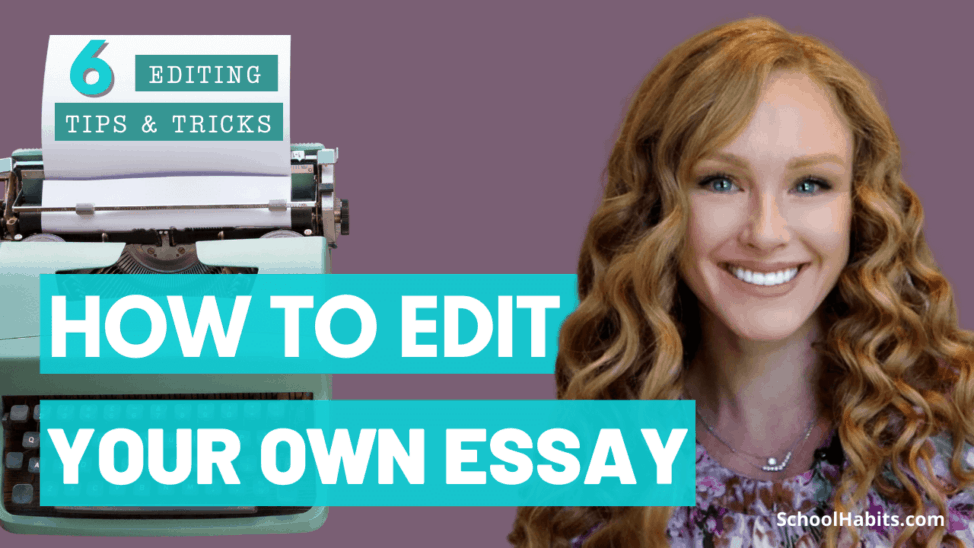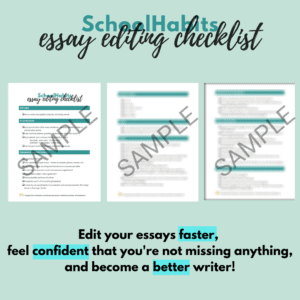By Katie Azevedo, M.Ed.
Knowing how to edit your own essay is a superpower. Sure, so is knowing how to write an essay – obviously – but knowing how to edit your own papers is what takes your writing to the next level.
As a writing teacher, I see it all the time: a student will look at a paper they’ve written and they literally don’t know how to begin editing. They think: It’s fine. I don’t know what else to do with it. Why is this?!
Why is it so hard to edit our own essays?
I think it’s tough for us to critique and edit our own essays for several reasons.
- First, we’ve been staring at them for so long that we no longer really see what’s in front of us.
- Second, we’ve been working on them for so long that we lost track of the big picture of our argument and are instead just focusing too narrowly on the components of our essays.
- And third, some of us struggle to edit our own papers because we literally don’t know what to look for because we’ve never been taught.
How to edit your own essay
The following 6 tips will help you edit your own essays systematically and thoughtfully. Don’t rush through these steps. I suggest your edit your essays on a different day than you write them.
1. Drastically reformat the paper.
If you’re typing your essay, change the font style, the font size and perhaps even the font color. Then print it out and edit the paper version. Making these small visual changes can have a huge impact on drawing attention to parts that need revision.
2. Read your paper aloud, to yourself and to someone else.
When we read aloud our essays, we hear how they actually sound instead of how we imagine they sound. Huge difference! Also, hearing our papers read in another voice provides us with another opportunity to catch errors that we otherwise would have missed, because it’s often easier to be critical of someone else than it is to be of ourselves.
3. Use a checklist.
A real checklist. On paper. Use this checklist to make sure you edit the paper for organization, proper punctuation, capitalization, spelling, word usage, citations, pronouns, subject-verb agreement, and fragments/run-ons. If you’re unsure about any of these rules, look them up. Here is my free essay editing checklist that has literally everything you will need to edit your essays.
4. Put the paper away for 24 hours.
I recommend editing your essay at least a day after you finish writing it. Giving your brain this time in between will allow you to see your work in a different, clearer light.
5. Stick your introduction paragraph above every body paragraph.
To edit for flow, read each body paragraph as if it came directly after your introduction paragraph. This won’t work for long and complicated papers, but for a basic ELA essay, this strategy can really help you check if your body paragraphs align with your introduction and thesis. Don’t know how to write a thesis? Here are some thesis tips.
6. Read from the bottom up.
To edit each body paragraph for clarity and content, read the essay from the bottom up. Correct, doing this will make your essay make no sense. But it’s a super cool hack for helping you to focus on editing one paragraph at a time without getting side-tracked by how the paragraphs connect to one another.
Final notes about how to edit your own essay
Knowing how to edit your own essay is a school habit that takes some tweaking for each individual. Some writers like to edit as they go, and others prefer to throw everything on paper and then edit it later. I suggest you write first and edit second, but you’ll have to figure out what works for you. No matter your editing style, these hacks should help stop careless errors from slipping right by you.
If you’re totally new to editing your own essays, you might consider trying out Tips 1 and 2 to start, and then gradually moving into the other editing tips.
If you struggle with how to start writing your papers, use these tips here.


